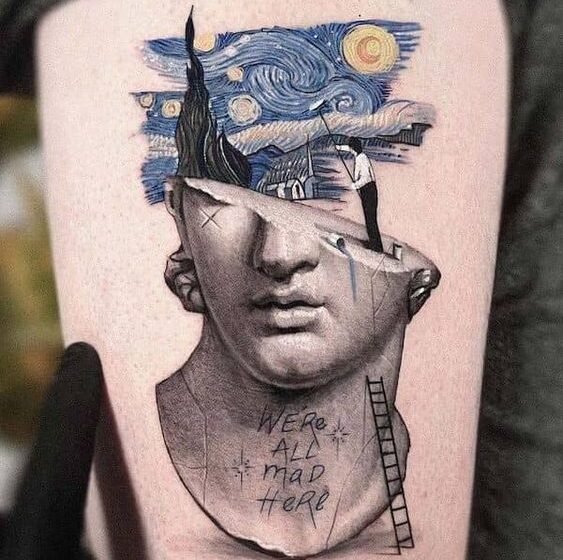Discovering Today’s Tattoo Trends: From Minimalist to Watercolor, Exploring Modern Styles and Cultural Fusions

Tattoos have long been used as a means of self-expression to symbolize important moments in life as well as religious and cultural ties. The tattooing industry has advanced significantly in recent years, with current trends exhibiting a synthesis of many styles, methods, and cultural influences. The emergence of minimalist tattoos, the attractiveness of watercolor tattoos, and the fascinating blending of many cultural traditions are some of the most recent tattoo trends that are discussed in this article.

The Development of Minimalistic Tattoos:
Minimalist tattoos have gained popularity in a time that is marked by simplified aesthetics and uncluttered patterns. These tattoos appreciate understatement and use delicate lines, light coloring, and simplistic images to produce quiet, exquisite patterns. Fine linework is a common characteristic of minimalist tattoos, which concentrate on components with deep symbolic implications. Those looking for a more covert way to express themselves may find this trend particularly intriguing. Wrists, ankles, and the area behind the ear are common places to find minimalist tattoos, which add a distinctive touch without overpowering the senses. Geometric patterns, one-line graphics, and succinct symbols with profound personal meaning are typical minimalist designs.

Tattoos in Watercolor: A Vibrant Form of Art
Due to their stunningly beautiful and artistic appearance, watercolor tattoos have become more popular. These tattoos feature subtle color mixes, delicate brushstrokes, and abstract forms that are inspired by the fluidity of watercolors, creating a beautiful and one-of-a-kind piece of body art. Layering transparent colors is a method used to replicate the erratic behavior of watercolor pigments. The capacity of watercolor tattoos to turn the skin into a canvas and provide the impression that the wearer is wearing a live work of art is one of its most alluring features. The style lends itself well to a variety of topics, from abstract representations of feelings and ideas to motifs drawn from nature like flowers and animals. It’s important to keep in mind, though, that watercolor tattoos demand a talented artist who comprehends the complex balance between bright colors and controlled dispersion. These tattoos have the potential to reproduce the aesthetic of a watercolor painting on the skin when done skillfully.

The ability of watercolor tattoos to depict subtle color gradients and gentle transitions is one of its most alluring features. These tattoos frequently feature ethereal images like abstract designs, animals, or landscapes. Each tattoo is a one-of-a-kind masterpiece because of the stunning visual impact that is produced by the employment of vivid colors and subtle shading.

Fusions of Cultures: A Tapestry of Customs
Cultural interchange has opened the path for the integration of several creative traditions in tattooing in our more linked globe. This fashion involves fusing aspects from other cultures, producing tattoos that honor intercultural relationships and represent a worldwide viewpoint. Beyond simple aesthetics, cultural fusion tattoos stand as a monument to the value of variety and the universality of the human experience. Symbols, patterns, and iconography from many civilizations are frequently combined by artists to produce beautiful and eye-catching creations. These tattoos might be a reflection of a person’s trip, their ancestry, or their profound admiration for the diverse civilizations of the globe.

For example, a person could decide to blend Polynesian designs with elements from Japanese irezumi to produce a special design that honors both cultures. Similar to how Indian mehndi may be used with modern geometric shapes to create a tattoo that is both aesthetically attractive and culturally significant. Cultural fusion tattoos are beautiful because they may bridge cultural and geographic divides and promote harmony and understanding among those from various origins. However, to ensure that the fusion is a celebration rather than an appropriation, both artists and individuals must approach this movement with respect and understanding.

Technological Advancements: Tattooing’s Future in the Making
Technology has had a big influence on the art of tattooing in addition to fashion trends. The development of tattooing tools, inks, and aftercare practices has made it possible to create more elaborate and durable patterns. A broader variety of colors are now available to artists, giving them a more creative license in their work. With the advancement of laser technology, it is now much simpler for people to entirely or partially erase tattoos that no longer speak to them. Having the opportunity to change their tattoos in the future has given individuals greater confidence, which has promoted experimentation.

Additionally, the rise of social media has transformed the tattoo industry, allowing artists to showcase their work to a global audience and enabling individuals to explore various styles and artists before making a decision. This accessibility has contributed to the diversification of tattoo styles and techniques, encouraging innovation and pushing artistic boundaries.

Conclusion:
In conclusion, Modern tattoo trends show a dynamic interaction between individual expression, creative innovation, and cross-cultural interaction. Tattoos that are minimalist embrace beauty and simplicity, watercolor tattoos blur the border between body art and fine art, and cultural fusion tattoos honor how linked the world is. The field of tattooing is expected to develop even further as technology advances, opening up new avenues for creative expression and self-expression. Tattoos continue to be used as a canvas by people to express themselves and engage with the world around them, whether the designs are simple or complex, watercolor or monochrome. The tattoo industry is always changing because of creative innovation, shifting cultural contexts, and the need for deep self-expression. The article’s discussion of current tattoo trends, such as watercolor artwork, minimalist ink, and the blending of ethnic customs, shows how dynamic and varied this age-old art form is. People are utilizing tattoos as canvases to communicate their experiences, celebrate their identities, and appreciate the wonder of human ingenuity, whether they choose a subdued symbol, a brilliant watercolor painting, or a cross-cultural fusion. The future of tattooing promises to be even more exciting and full of artistic potential as technology continues to improve and cultural borders continue to melt.


